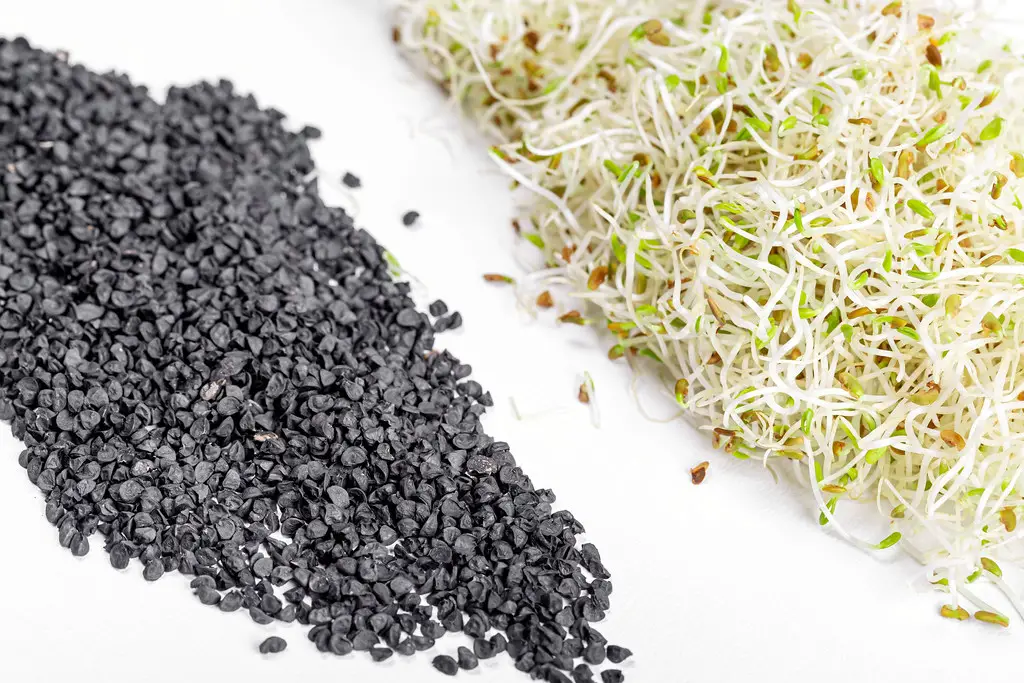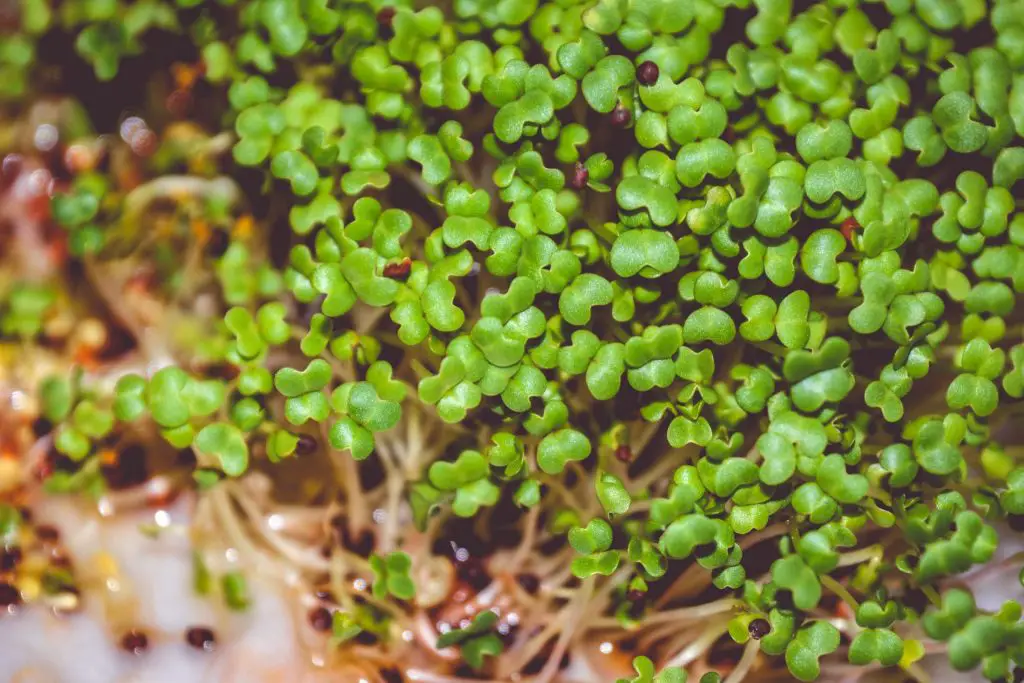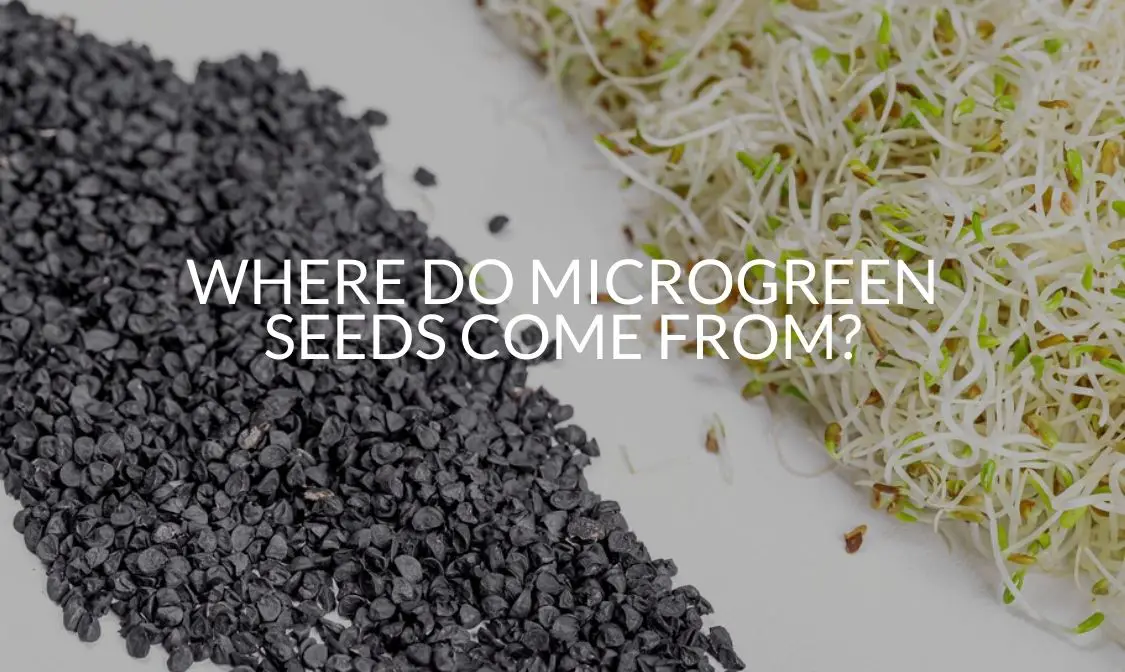You may have noticed microgreens at your local grocery store. These tiny vegetables are becoming popular among health food lovers because their nutrient content is concentrated. Microgreens are still relatively new to most kitchens and people have many questions about them still, like where do microgreen seeds come from?
There’s nothing to be freaked out about when it comes to microgreens. Even though they are a newer item in the produce aisle, their seeds are derived from vegetables that you are probably already familiar with. Keep reading to learn more about microgreen seeds and where they come from.
Are Microgreen Seeds Different From Regular Seeds?
Some nurseries sell seeds labeled “microgreen seeds” to grow these little plants specifically. However, the truth is that microgreens can be grown from regular seeds. There really is no difference between microgreen seeds compared to regular seeds. Actually, the time of harvesting plays a bigger role in growing a microgreen than the seed used.
This is because microgreens aren’t harvested like regular vegetables. While a lot of vegetables get harvested from the roots, microgreens get harvested before they reach full growth. They are usually grown under different conditions too, in shallow containers that have several drainage holes. While their growing conditions are different from regular plants, the seeds remain the same.
Can You Use Regular Seeds As Microgreens?
Yes, you can use regular seeds as microgreens. Actually, many of the seeds in which you get microgreens from you may have used before to grow plants. Some of the most common seeds to grow microgreens from are:
Where do microgreens come from? There are so many different seeds that can be used to grow microgreens, it isn’t limited to the ones listed above. Most herbs and vegetables can be used to grow these nutrient-packed young vegetables.
How Do You Get Seeds From Microgreens?
One common way gardeners get seeds from microgreens is to save the seeds from their previous plants. What they do is allow their vegetable plants to go to seed. Once the plant is ready, they will harvest the seeds to save for their next crop. Many gardeners used these saved seeds specifically for microgreens.
It is recommended to leave the seeds on the plant until they are dry and a brownish color (depending on the plant). However, you will need to keep a careful watch on the seeds because the seed-heads will eventually split open and you need to collect the seeds before this happens.

What Differentiates Microgreens From Normal Plants?
The difference between microgreens and other plants is that microgreens are actually small edible leaves that are ready in less than three weeks. Young greens have been studied for their many nutritional benefits, which is the main reason people have taken such a big interest in these leaves.
What really sets a microgreen apart from the sprout of a normal plant is that the seeds don’t get consumed. Microgreen seeds are still under the soil and many can continue to grow more leaves.
What Seeds Are Not Recommended For Microgreens?
While there are so many different types of seeds from which you can grow microgreens, there are still some that won’t bring you very much luck at all. Surprisingly, lettuce seeds are not a good choice for microgreens. This is because lettuce leaves are so delicate and they have trouble surviving the microgreen cultivation process.
When choosing a type of seed to grow microgreens from, it’s important to choose a vegetable that doesn’t wilt easily. Unfortunately, many types of lettuce leaves can wilt very easily. This is why it’s important to choose a hardier green leafy vegetable, such as kale or chard, for growing microgreens.
Another type of seeds to avoid is vegetables that grow on a stem. This is because people consume the leaves and stems of the microgreens. Try to avoid using seeds of vegetables with inedible stems and leaves, such as:
- Tomatoes
- Peppers
- Tomatoes
- Zucchini
- Squash
- Eggplant
- Okra
For the same reason, most fruit seeds aren’t suitable to grow microgreens from. Not only are the stems and leaves inedible, but they also have a very unpleasant flavor. Microgreens are known for the bold and aromatic flavor they bring to dishes. If they are ever grown from a seed with inedible components the taste will be off.
Related Articles
- Do Microgreens Regrow? (Or Should You Replant?)
- Microgreens Humidity And Temperature (Complete Guide)
- What Are The Best Tasting Microgreens (And What Do They Taste Like?)
FAQ
Now you have a better understanding of where microgreens come from. However, since they are still so new to the culinary world, people have many questions about microgreens and their seeds. Keep reading to find the answers to all your frequently asked microgreen questions.
Why Are Microgreen Seeds So Expensive?
If you can grow microgreens from regular seeds, why are microgreens more expensive? This is because microgreens are specialty seeds and need a higher germination rate. Because of this, microgreen seeds need to be kept free from any residues or other harmful contaminants.
(Find out more about why microgreens are so expensive.)
Why Are Microgreens More Expensive Than Other Produce?
The reason microgreens are more expensive than other vegetables has to do with the growing process. In order to grow microgreens, the gardener has to purchase many specialty items and most of them cost a higher price. Everything from the light to the soil and even the many seeds needed to produce a full batch costs more for the gardener.
If they were not sold for a premium price the gardener will end up losing money on their harvest. In order for them to make a profit off of their hard work, they will need to charge more money than they would for lettuce or mushrooms.
How Long Does It Take To Grow A Microgreen From Seed?
The wonderful thing about growing microgreens compared to other vegetable plants is that they are ready to harvest much faster than any other edible plant. Most of the time microgreens are mature and ready to eat within 10 to 14 days. However, some types may take up to 3 or 4 weeks until they are ready. Most microgreens are ready to be harvested once they are 2 inches tall.
Will Microgreens Regrow After They Have Been Harvested?
This depends on what type of microgreen seed has been planted. Many microgreens can continue to grow after they have been harvested because the seed is still in the soil. However, not every type of microgreen will continue to grow so it’s important to research the type you are growing ahead of time.
If you do want to continue to regrow the microgreen, make sure you cut the plant just above the lowest leaf. This will increase your chances of growing another round of delicious leaves. Most microgreens have a better chance at regrowing if they have been repotted into a bigger container.
Can Microgreens Be Grown From Flower Seeds?
While many fruit seeds are out of the running to grow good microgreens, certain flower seeds can grow a very tasty batch. Actually, anyone who enjoys a nice floral tea may enjoy the flavor flower seed microgreens add to a dish. The taste is surprisingly delicious and they also make elegant garnishes.
Some of the flower seeds that can be used to grow microgreens are:
- Sunflowers
- Dandelion
- Marigold
- Borage
- Celosia
Out of all of these flowers, most beginners have the best luck with growing microgreens from sunflower seeds. This is one of the best types of seeds to start with because they are easier for new gardeners to learn how to care for their microgreen plants properly.

What Seeds Should I Use For The Fastest-growing Microgreens?
Some microgreens will grow faster than other types. If you are interested in growing a microgreen within the 10 to 14 day range then you should be using any of the following seeds:
- Kale
- Broccoli
- Cabbage
- Collards
- Borage
- Cress
- Radishes
- Mustards
While these aren’t the only options for fast-growing microgreens, they are some of the most popular types and some of the easiest to grow if you’re looking for a fast grower. These are the best seeds to go for if you’re an impatient gardener. Most herb seeds, such as basil or dill, take longer to grow.
What Are Microgreen Mixes?
Since the microgreen trend has started to emerge, many nurseries and retail establishments have started selling microgreen seed mixes. This is a great option for gardeners who still aren’t sure which types of seeds they want to experiment with. One of the most popular microgreen seed mixes is chard with beets.
There are so many different varieties that can be done with microgreen seed mixes. Another tasty combination for those who want to add some spice to their dishes is a mixture of red and green mustard seeds. For a more mild blend, retailers often sell a mixture of kale, cabbage, kohlrabi, and mizuna. When it comes to microgreen mixes, the options are endless.
How Can You Prepare Microgreen Seeds For Planting?
Before planting a microgreen seed it’s important to make sure it’s germinated. With smaller seeds, it’s okay to go through the regular germination process. However, with larger seeds (such as sunflower, beetroot, or peas) it’s a good idea to help them germinate a little bit faster.
To do this, you should soak the larger seeds in a sealed bag or container of warm water. Let them soak overnight to give them enough time. After soaking, make sure that you drain the seeds and thoroughly rinse them afterward.
Final Thoughts: Where Do Microgreen Seeds Come From?
Even though microgreens seem completely different than any other type of vegetable we regularly eat, their seeds are the exact same. Gardeners can use regular seeds to grow microgreens, it’s the growing and harvesting process that is different. However, not every type of seed will result in a good batch of microgreens.
When choosing a type of seed to grow microgreens from, it’s important to make sure all aspects of the plant are edible. Many fruit seeds aren’t a good choice because the leaves and stems aren’t edible. If you attempt to grow microgreens from the wrong types of seed the result will be an inedible plant that could even be toxic for consumption.
Other than that, microgreens don’t require any sort of special seed. Many retailers sell microgreen seeds or microgreen mix seeds, which are a great starting point for beginners. Gardeners with more experience should be able to grow microgreens from several other types of seeds.
Sources
- https://donotdisturbgardening.com/do-you-need-special-seeds-for-microgreens
- https://www.microgreenscorner.com/are-microgreen-seeds-different-from-regular-seeds/
- https://themicrogardener.com/easy-guide-to-growing-microgreens/
- https://www.juliasedibleweeds.com/raw-food/microgreens-from-your-own-saved-seed/
- https://www.seedsnow.com/blogs/news/whats-the-difference-between-sprouts-and-microgreens
- https://www.greenmatters.com/p/grow-microgreens-at-home
- https://tinygreenfarm.com/why-are-microgreens-so-expensive/

